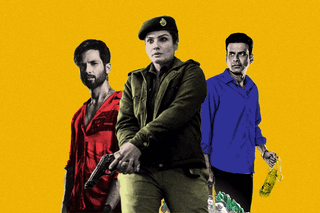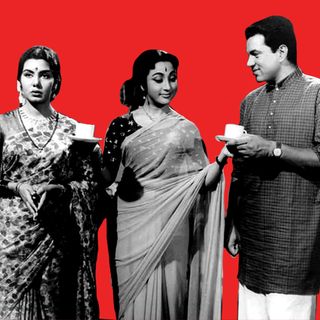
A New Genre of Indian Entertainment Wants to Look Politically Edgy, But Ends Up Being Inherently Apolitical
With increasing focus on cops, spies, soldiers, and political workers, Indian media is experimenting with a new sphere of storytelling where politics remains ambiguous but the state always comes out on top.

A key element of Farzi, last month’s superhit Amazon Prime Video show, is its protagonist’s relationship with his idealistic grandfather’s printing press. The show’s writers tell us that his grandfather used to publish a struggling magazine, “Kranti,” with which he wants to change the world. However, they tell us nothing about what the revolution really stands for or the political motivations behind his grandfather’s dream. And by showing the protagonist eventually moving away from working for the magazine and its unstated cause, they also tell us that activism or even the idea of revolution is a futile endeavor.
Thus, Farzi joins a bandwagon of films and shows that are simultaneously set in a political milieu while being largely and willfully ambiguous about their ideological leanings. These non-committal stories feature the likes of militants, spies, soldiers, police officers, political workers, etc. and go on to become massively popular and critically acclaimed. Some notable examples include Family Man, Aranyak, Aspirants, Guilty Minds, Chacha Vidhaayak Hain Humaare, and Pathaan. In fact, these apolitical “political” projects mark a new cultural moment in Indian media.
To understand what has led to the rise of such apolitical content, it is first important to understand what attracts so many filmmakers to the political milieu in the first place.
“Today, more than any time in the past, there is a huge market for political films and shows. Anything that is political gets the immediate attention of the market, the social media, the audience, because everybody wants to talk about something that is political,” explains Rajesh Rajamani, an independent film-maker, visual artist, and culture commentator.
Globally, this rise in the appetite for political content parallels and is partly influenced by increasing political awareness in society. Debasmita Bhowmik, founder and editor-in-chief of Incurato Magazine, points out, “news of political rallies and demonstrations across the world have become more commonplace, leading to a rise of a highly politically opinionated audience.” This audience then seeks out politics in its cinema too, which in turn creates “almost a pressure on stars and filmmakers to say something directly political to appeal to their audience,” says Rajamani. “Being vocally political has become sort of a marketing technique to reach today’s audience,” he adds.
Unsurprisingly, Indian filmmakers too have tried to make the most out of this phenomenon. In fact, with the resounding success of films like The Kashmir Files and Uri: The Surgical Strike, several filmmakers have tried to ride prevailing majoritarian sentiments to find box office gold and state approval through a vast sea of forgettable films and shows trying to ape the political formula.
However, while social media and global connectivity have contributed to increased political awareness, they have also created intense political polarization. In such a polarized, trigger-happy environment, audiences are often offended by content that seems to take a political stance opposed to their own.
A lot of “political” projects thus try to remain subtle and vague about their allegiances and beliefs. While the stories are set against political backdrops, they largely focus on the personal stories rather than exploring larger ideological moorings directly.
Related on The Swaddle:
Why Bollywood Moved Away From Urban Romances in Favor of Small‑Town Ones
The fear of offending a numerically significant section and thus facing huge commercial losses also extends to the politics of the real people involved in making this content. In 2017, the release of Baahubali 2: The Conclusion faced problems in Karnataka after a viral clip of its Tamil Nadu-based star Sathyaraj claiming his state’s rights over the river Cauvery. In 2020, after Deepika Padukone chose to stand by the victims of right-wing violence at the Jawaharlal Nehru University, Hindu nationalists ran a prolonged campaign against her then-upcoming film Chhapaak. Similarly, last year, Aamir Khan’s comeback film Laal Singh Chaddhawas targeted by right-wing groups for his past comments on growing intolerance in the country. Both Chhapaak and Laal Singh Chaddha failed to perform at the box office.
Beyond these commercial risks, filmmakers that offend powerful groups and political factions also face other forms of trouble – at times in the form of extrajudicial vigilantism and even state action.
Pallavi Rao, assistant professor at the Department of Media Studies, University of Virginia, recalls the fate of Tandav, a political drama that was released in January 2021 on Amazon Prime Video. The show boasted of a star-studded ensemble and focused on the interactions between university-level student politics and national-level politics. Notably, the show – that begins with a depiction of the suppression of a protest by farmers – was released in the middle of actual nationwide farmer’s protests.
Predictably, Tandav ran into trouble with the ruling party and Hindu nationalist outfits soon after the first season aired. A long online hate campaign was launched against the show, initiated by a leader of the ruling party and fuelled by several Hindutva influencers. Following this, a police complaint was filed against the actors and makers of the show, as well as against the Head of India Originals at Amazon Prime Video, for hurting religious sentiments of Hindus. The basis of the complaint was a scene that featured Muslim actor (and a known vocal critic of the current government) Mohammed Zeeshan Ayyub dressed as the Hindu deity Shiva in a stage play.
All of this also triggered the central government to come up with a set of “Intermediary Guidelines and Digital Media Ethics Codes Rules 2021,” aimed at regulating social media and streaming platforms. The language of the code was vague and ambiguous but hinted that content found to be offending religious or caste-based sentiments could attract strong action in the form of censorship from regulatory bodies.
Filmmakers are therefore trying to play it safe by not openly endorsing any political ideology, even as they try to cater to the market’s appetite for political content. In fact, one way filmmakers have tried to achieve this is by claiming that they are apolitical themselves and that their work primarily is only made to entertain people. Raj and DK, the makers of successful shows Family Man and Farzi, claimed in multiple interviews and public appearances that they “were not making anything political” but instead were just trying to tell “human stories.” More recently, when SS Rajamouli was quizzed about the recurring caste-supremacist and Hindu nationalist themes in his work, the superstar filmmaker of Telugu cinema claimed that his films were written purely for entertainment and that he didn’t care about politics.
But, as Bhowmik points out, “it is not really possible to keep politics away from any art that someone makes. We do not occupy an apolitical world, so any art produced here would also not be apolitical.” Rao adds that the desire to claim an apolitical position may not just result from wanting to play things safe but also from just a general ignorance on the filmmakers’ part in understanding what it means for all art to be political and how art is and can be used as a political tool – consciously or otherwise.
Filmmakers also try to indicate their apolitical stance by including multiple ideological standpoints in their work through their different characters and leaning into each of them to bring out the tension in the plot. This can be seen prominently in the works of Raj and DK, as well as in other recent works revolving around the political system, including in shows like Panchaayat or Pataal Lok.
This sort of writing, however, does not fully erase the presence of politics and ideology from the story but engages with these notions in a very hollow, surface-level manner. Hence, in Farzi, there is hardly anything very revolutionary about a character who runs a magazine called “Kranti.” “Unlike real-life leftist figures who run magazines and newspapers like this, Amol Palekar’s character is not really involved in any ground-level or grassroots politics,” Rao points out. The idea of “kranti” is purely cosmetic and is played out simply for building up the disillusionment that the protagonist Sunny, played by Shahid Kapoor. Sunny embodies the emotion of middle-class angst for not being accorded enough fair opportunity in life for gaining social mobility. However, this angst is never analyzed through the lens of class struggle and instead blamed on a nondescript “system.” The show makes no effort in identifying the definite people, forces, and structures that are responsible for keeping this system running in the first place.
In making such apolitical work, designed solely for entertainment, the makers lose out on important nuances, missing a chance to make their story more grounded in reality or exploring ideas that challenge the status quo. When these stories repeatedly feature the position of the status quo as the natural position to take, it sends out the message that there is nothing wrong with how things are functioning in the real world.
Related on The Swaddle:
Spy, Cop, and ‘Astra’ Universes Taking Over Cinema, Points to the Marvel‑ification of Bollywood
However, while Indian – and significantly, Hindi-language – content is largely trying to remain apolitical, there has been at least one significant outlier. In the last few years, the anti-caste movie has become a definitive genre in Tamil cinema. Star filmmakers and actors have helmed movies that have openly and distinctly voiced Dalit experiences and angst at the Brahmanical order and have garnered not just critical praise but also commercial glory.
An editorial in The Hindu, marking a decade of filmmaking by Pa. Ranjith – one of the tallest figures of radical anti-caste cinema – noted how his filmmaking choices have been a significant catalyst marking this great change: “In the 1990s and 2000s, Tamil cinema was churning out movies that were centered around a dominant caste,” the piece notes. However, post Ranjith, “it is no more acceptable to portray Dalit characters, women, transgenders, queer from the disadvantaged sections of the society negatively on screen.” Further, the success of Ranjith – who during his early years used to struggle to find producers to back his movies – as a filmmaker has directly inspired and emboldened numerous other young Dalits to enter cinema professionally.
Ranjith’s trajectory highlights the impact that political cinema, and taking a stance by using movies as a medium, can have in shaping popular culture as well as the politics around it. A majority of Ranjith’s post-2014 work has been commercially successful and yet been fiercely radical in its political commentary. Further, the recent changes in the political climate haven’t affected Ranjith’s incisive, anti-conservative stance in his films.
Yet, in the context of Hindi cinema, where a major part of the audience remains conservative, such a radical stance still remains commercially unviable for producers.
But does that mean that radical political critique should not be expected of the medium at all? Rao argues that, even with its limited space to make bold political statements, at times popular commercial entertainment can leave viewers with enough hints and ideas to think about and read into.
She cites the example of the recent Shah Rukh Khan-starrer Pathaan and its antagonist Jim, played by John Abraham. “A lot of things Jim says in the film – such as his distaste for how the army treats its soldiers, or him having moved beyond the conception of a state – are actually ideas that a lot of radical and progressive people around the world are talking about right now. Those who want to read into these lines are reading into it, trying to interpret it in their own way.”
But Jim still remains the antagonist, and a very conventional one at that. At the end, his character is meant to be defeated and vanquished, and the audience is left with the message that a soldier is to never question his duty toward his country.
In the end, then, as is with all things apolitical, the state emerges on top.
Amlan Sarkar is a staff writer at TheSwaddle. He writes about the intersection between pop culture and politics. You can reach him on Instagram @amlansarkr.
Related


Woe Is Me! “I’m Upset That My Best Friend is Dating My Ex‑Fling. Am I Being Petty?”
